Otto Lilienthal: bird flight as a basis of aviation, New York 1911
XXXVIII
The Bird as our Model
From all the foregoing results it appears obvious that in order to discover the principles which facilitate flight, and to eventually enable man to fly, we must take the bird for our model.
We have seen that there are so many remarkable advantageous mechanical features in actual birdflight, that we would have to abandon all hope of flying if we would forego their employment.
It may therefore be permissible to once more investigate the phenomena characteristic of birdflight. Of course, in choosing birds as our model we shall not select those species the wings of which are almost rudimentary, such as is the case with some running birds. Small birds, likewise, such as the swallow, do not lend themselves for our purpose, though we may admire their skill and perfect mastership of flight; they are too small, and their incessant hunting for insects introduces too many erratic movements.
A specially suitable species of birds to act as our model is the sea-gull.
The best place for studying these birds is at the sea-shore, because not being hunted, they are very friendly with man, and disport themselves at close quarters. We are therefore able to clearly distinguish every movement of their wings, and knowing the peculiar properties of air pressure in connection with birds' wings, we may gradually solve some of the problems connected with their beautiful method of flight. What applies to the gull, applies more or less to all other birds and flying creatures.
How does the gull fly ? As a rule the air near the sea is disturbed, and this enables the gull to sail along, only assisting from time to time with a few wing-beats, but rarely circling, now turning to the right and now to the left, ascending, descending, the head inclined, and constantly scanning the sea for food.
At the very first glance we notice that the slender, slightly curved wings execute a peculiar motion, in so far as only the wing-tips move appreciably up and down, whilst the broader arm-portions near the body take little part in this movement, a condition of things which is illustrated in Fig. 76.
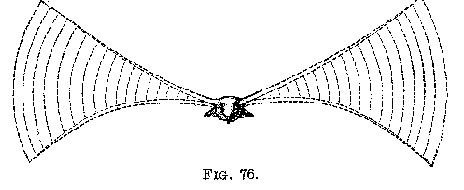
Does not this peculiarity show us another means of facilitating flight, and of reducing the necessary expenditure of energy? May we not assume that the comparatively motionless parts of the wings enable the gull to sail along, whilst the tips, consisting of easily rotating feathers, serve to compensate for the loss of forward velocity ? It is unmistakable that the wide Portion of the wing close to the body, which does little work and has little movement, is intended for sustaining, whilst the narrower tips, with their much greater amplitude of movement, have to furnish the tractive power necessary to compensate for the resistance of the bird's body and for any possible restraining component.
This being conceded, we are forced to consider the flying apparatus of the bird as a most ingenious and perfect mechanism, which has its fulcrum in the shoulder joint, which moves up and down, and by virtue of its articulation permits of increased lift or fall as well as of rotation of the light tips.
The arm portion of the wing is heavy, containing bones, muscles , and tendons, and therefore opposes considerable inertia to any rapid movement. But it is well fitted for supporting, because being close to the body, the air pressure upon it acts on a short lever arm, and the bending strain is therefore less severe on the wing. The tip is very light, consisting of feathers only, and can be lifted and depressed in rapid succession. If the air pressure produced by it increased in proportion to the greater amplitude of movement, it would require a large amount of work; and would also unduly strain the wings; we therefore conclude that the real function of the wing-tips is not so much the generation of a great lifting effect, but rather the production of a smaller, but tractive effect directed forward.
In fact, actual observation leaves no doubt on this point. It is only necessary to watch the gull during sunshine, and from the light effects we tan distinctly perceive the changing inclination of the wing-tips, as shown in Figs. 77 and 78, which refer to the upstroke and downstroke of the wings respectively . The gull , flying away from us, presents at the upstroke, Fig. 77, the upper side of its wings strongly illuminated by the sun, whilst during the downstroke (Fig. 78) we have tlie shaded camber presented to us from the back. The tip evidently ascends with the leading edge raised, and descends with the leading edge depressed, both phases resulting in a tractive effect.
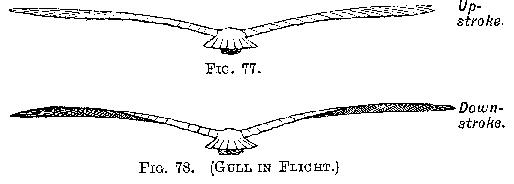
Also, when flying past us, the gull will enable a trained observer to judge of the wing-tips.
Fig. 79 illustrates the gull just before beating its wings down-ward; towards the tip the wing has the cross-section abc which is inclined forward, and the absolute path of which is represented by line cd, whilst ce is the resulting air pressure. The simultaneous lifting and tractive effect of the latter is clearly noticeable.
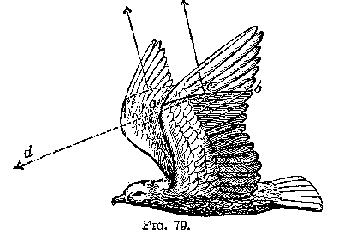
It is not so certain whether all parts of the wing play a similar part during the upstroke ; if it were so, then it would also imply a downward pressing effect. Perhaps it is so more especially when the bird desires to attain very great speed.
The upstroke may also take place under such an inclination that there is no pressure at all, either from above or from below, and finally it is possible that a peculiar kind of upstroke may produce a lifting effect, in which particular case we have the remarkable conditon for which all parts of the wing act in a lifting sense during the whole period of flight - a condition which, as we have seen in a previous section, influences the possible saving of work in the most effective manner.
Of course, the upstroke will produce less lift than the down-stroke, yet if the former results in only so much pressure from below that it lifts the wing and compensates for its mass inertia, it helps the bird, because practically no forte is then necessary to lift the wings.
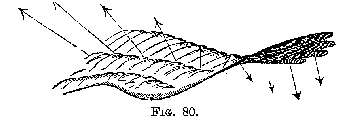
It is also possible that the air pressure (during forward flight) upon the lifted and warped wing is so distributed as to produce a lift on the arm Portion, whilst the effect on the wing-tips is of a tractive nature, as indicated in Fig. 80. In this case the detrimental downward components acting upon the tips are compensated and overcome by the upward components on the broader part of the same wing.
We can therefore imagine that during this kind of flight, even during the upstroke of the wings, there still exists a partial lifting effect, that no diminution of the flight velocity takes place, and that there remains, possibly, even a small forward propelling plessure.
A simple calculation will prove that the above considerations are correct. Compare the rise and fall of the centre of gravity of a bird which was supposed to be only lifted during the downstrake of the wings, with the actual rise and fall as determined by observation.
A large gull rises and falls, even during a calm, barely 3 cm., although with 2 1/2 wing beats per second this figure would be 10 cm., if it were based upon all the lifting effect being due to down-strokes only.
The sinusoidal curve, Fig. 81, represents the absolute path of the centre of 'gravity for a seagull executing the upstroke of the wing without appreciable resistance, but also without lifting effect.

Assuming an equal period for the up and downstroke, each would occupy 1/5 second. The gull commences to lift its wings at a ; the initial upward speed diminishes under the influence of ist weight, and is converted into a downward velocity, so that the path of the centre of gravity describes the parabola abc, during the period of wing lift, i.e. during 1/10 + 1/10 second. In accordance with the law of gravity the distance s for the time t equals, s = 1/2gt², g standing for 9.81, and (for the gull) t = 1/10 sec.
s = 1/2 x 9.81 x 1/100 = 0.05 m. = 5 cm.
From c the play of the wings is reversed, the latter beating down-ward and producing an air pressure equal to twice the weight of the bird, so that the remaining lifting forte equals the weight of the gull. The centre of gravity now describes the negative curve cde, for which s also equals 5 cm., thus giving a total of 10 cm. for rise and fall, as above stated.
The result of the calculation will be somewhat different when assuming a less time for the upstroke than for the downstroke ; but even if we apply only 2/ 5 of the whole period to the former phase, the centre of gravity still moves more than 6 em., and we are forced to assume the existence of a lifting component during the upstroke of the wings in order to reconcile calculation and observation.
This property of wings constitutes a further facilitating factor in flight, and is an advantage accruing from the up and down movement of the wings in which the amplitude increases from the root to the tip.
Every part of the wing therefore moves in a different, absolute path. The parts close to the body barely rise or fall, but possess essentially only a horizontal velocity, and their function corresponds to that of the whole wing in "sailing" flight; their position should therefore the such as to produce a maximum of lifting pressure without undue restraining cotiponent. The unavoidable retardation of forward flight, chiefly due to the body itself, is compensated by the oblique forward pressure which results from the fact that the wing tips automatically assume a forward inclined position during the down-beat and the latter portion of their absolute path, a pressure which suffices for the maintenance of the desired forward speed.
During the upstroke of the wing, the wing portions close to the body continue to act as supporting planes, but the parts near the tip, which execute a greater movement, and the absolute path of which is directed obliquely upward, will be so turned that they may attain the top position as quickly as possible, and without experiencing much resistance. We can therefore imagine that the various parts of the wing describe lines of a different amplitude (as shown in Fig. 82), and the several wing sections assume positions, and produce air pressures, similar to those shown in this illustration. It is assumed that all parts of the wing produce a lift during the upstroke.

The resultant force of these air pressures must be large enough and so directed that they balance the weight of the bird, as well as the air resistance opposed to the body of the bird.
For this purpose it is necessary that the bird's wing rotates during the upstroke and downstroke, very little near the root, and considerable near the tip. The rotation will take place when the direction of the stroke is reversed, and since this reverse always takes a certain amount of time, we may assume that there is a small loss; it will decrease as the wings decrease in width. As an example, we would mention the albatross, the wings of which have a width of only about 1/10 of their length, and which are shown on p. XXII, in 1/30 scale. This may be the reason why Nature has resolved the tips of the wings into pinions in those in those birds which have very wide wings; the dense part of the wing is only called upon to execute very small rotations, whilst the large rotation is executed by each pinion singly.
These single pinions form, as it were, narrow curved wings, which, in order to rotate freely, must not overlap. Every observer of the flight of storks will have noticed this play of the teathers, since during the two phases of the wing movement, one is able to periodically see through the wings.

Fig. 83, which illustrates such a pinion from a condor, shows how carefully Nature designed them. Near the root, the pinion is 75 mm. wide, and at the point a it has the cross-section shown in Fig. 84, a section which is peculiarly capable of reaching below the adjacent feather, and so to form a closed surface.

The part of the pinion towards the end of the quill is narrower on both sides, namely, 48 mm. wide at b, and 55 mm. at c. Fig. 85 gives the section through this narrower part, which almost represents a separate ming. The figure is drawn to actualsize, and well illustrates the parabolic curvature assumed when the bird is circling in the air. Such pinions are so rigid that, although they may bend in the direction of their length, their cross-section changes but very little.
If we treat such a feather in accordance with § XXVII., Fig. 45, we find that it shows a torsion which commences at the quill and increases towards the tip ; this torsion is brought about by the fact that the posterior beard is about six times as wide as the anterior. This feature is in perfect accord with the function of the feather, i.e. to produce air pressures which have a forward tractive effect.
Thus we see that every single pinion is really intended to be a small separate wind, which is able to execute the necessary movements, especially rotations.
This is very clearly to be seen in Figs. 86 and 87, which represent the mechanism of the wing of a condor during the upstroke and downstroke.
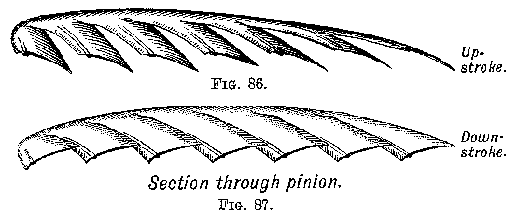
Another point which is indicative of the separate effect of these Single pinions is their greater width towards the end (see point c, Fig; 83), a feature which evidently enables the surface to be more perfectly utilized.
This rotation of the pinions is not entirely due to the tendons and muscels of the bird, nor does the difference in the degree of tension of the follicles in which the quill is assisted by some of the beard on each side of the quill.
Nature never introduces any feature without a purpose : the construction of these feathers obviosly indicates their use, and shows them to be the resolution of a large, wide, and close wing into serveral narrow and easily rotating wings, which do not overlap, so that the posterior, wider beards are able to rotate into their proper position on the down-beat, if not by muscular effort on the part of the bird, then at least automatically by the wind pressure.
This is one of the chief charactaristics, applying to the pinion meachanism of all the larger birds of prey and marsh birds, which allows of no other interpretation.
We cannot leave this subject without once more reverting
to that bird which seems to have been created for the purpose of serving
as a model for human flight, one of the largest species of birds inhabiting
our continent, a past master of every type of fligh, and one whom we have
unique opportunities of observing in his natural state, and in the full
freedom of his movements. We refer to the stork, which, being born upon
our houstops, spending there is early youth, and reciving his flying lessons
from his parents in the air above us, returnes from his second home in
the far interior of Africa to visit our plains.
(The following often quoted poem (section in Brackets >>> <<<) is missing in the 1911 edition. Translation has been added by M. Buckow and G. Evans, Greifswald, 2000)
>>>The impression could be given that the only reason for the creation of the stork was to awake in us the desire to fly, to act as a teacher to us in this art. One almost hears him crying out a warning:
O, see the delights that are with us there,
When, circling, we are borne in the warm blue air.
Stretching out far beneath our gaze
Your splendid, sun-lit world so fine.
And over us the sky's canopy sublime,
Where only your eye with us plays.Our plumage carries us, our broad domed wing
Borne up high by the wind's lifting.
Flight is no trial for birds:
No beat of the wings disturbs the sublime peace.
O man, in the dust, when will you find this ease?
When will your foot be loosed from the earth?And when evening arrives, and the air grows calm
We come again down in the golden balm
And from the lonely heights depart.
The beat of our wings carries us peaceful and light
Towards the village before the sun's flight
Then we want to be where you are.So you see us carried in a low flight
Over the gardens in the red of twilight.
We return to our nest:
Soon we find sleep in our shrine,
Dreaming of wind and bright sunshine,
And giving our feather'd limbs rest.If driven by yearnig, like we are in flight
To glide away in the realm of the hight,
Enjoying what flying can bring -
Then see our wings and measure our powers
And study the lift, which force is ours,
Concluding the works of our wing.Then seek that which carries us there
Whilest our pinions gently stroke the air
Whiles our flight goes on, ever untiring!
That which was bestowed by a gracious creation
May lead you then to the due realisation
And solve the enigma of flying.O! Just apply the power of thought:
An eternal ban must not be wrought -
also you will be borne by the ether.
It cannot be your Creator`s will
To doom you, the first He made, to earth until
Eternity, to refuse you flight for ever.<<<
What is it which causes the stork to seek the company of man ? Surely he is not in need of our protection, since he need not fear any enemy in the animal kingdom; marten and cats, which might menace his offspring, are more plentiful upon the roofs thean in the woods, though a thrust from his bill would soon despatch them. The black stork, which, although easily tamed in captivity, is not so found of the human species, would leave him suffient trees wereon to build his nest firmly and savely, so that we cannot imagine it to be the scarcity of likely refuges which causes the bird to prefer human habitations. Is he likely to be attraced by the human voice or song, or does he appreciate other human activities ? How is it possible to solve these questions without gaining an understanding of the peculiar chattering of the bird ?
At any rate, this friendship and, close association of man and stork dates back to remote, prehistoric times ; and we can only rejoice that-whatever the cause-one of the largest and most skilled flyers approaches man at a time when genial weather conditions invite us to spend our time in the open, and enable us to study his perfect flying movements.
The quiet village, rather than the big town, attracts the stork ; there he seems to be at ease, and to be most friendly to man. He seeks his food in closest proximity to the farm labourer. Not being able to walk in the high growth of the cornfields or to ascend from them, he follows in the wake of the harvester, and many a field mouse falls victim to him. This useful occupation is, in turn, appreciated by the farmer, who takes every possible care of the bird.
Thus is not to be wondered at if the farmers, above whose homesteads these birds with a span of two metres hold great flight meetings every year, evince great interest in the art of flight, though they do not wish it to be known, fearing ridicule. Nevertheless, from no other trade or profession have so many inquiries for light engines - for a secret purpose - reached the author, as from farmers.
If there is much interest attached to the observation of the free living stork, the association with properly domesticated storks is full of interest and instruction. A young stork from the nest can be easily brought up on meat and fish, and soon gets attached to his keeper, becoming friendly to a high degree.
Many observations can be carried out whilst the young bird practises flight. Their home has been transferred from the roofs of distant villages to our garden, where they make themselves most useful by destroying field pests. It is but seldom that more than one young stork may be obtained from one nest, which us a rule contains four young birds, because the owners of the houses are greatly attached to the birds, and resent any molestation of the stork family.To obtain a number of storks, several nests, and generally several villages, have to be put under contribution. Especially when breeding from the domesticated birds, such pairing of storks from strange families is absolutely necessary, since the stork is averse to intermarriage, and birds from the same parents never pair.
When the actual flying practice begins, the first attention is devoted to the determination of the wind direction ; all the exercises are practised against the wind, but since the latter is not so constant on the lawn as on the roofs, progress is somewhat slower . Frequently, a sudden squall produce s eddies in the air, and it is most amusing to watch the birds dancing abou t with lifted wings in order to catch the wind which changes from one side to another, all round . Any successful shortflights announced by joyful manifestations. When the wind blows uniformly from an open direction over the clearing, the young stork meets it, hopping and running, then turning round, he gravely walks back to the starting point and again tries to rise against the wind.
Such exercises are continued daily : At first only one single wing-beat succeeds, and before the wings ta n be raised for the second beat, the lang , cautiously placed legs are again touching ground . But as soon as this stage is passed i.e. when a second wing-beat is possible without the legs touching the ground, progress becomes very rapid, because the increased forward velocity facilitates flight, and three, four, or more double beat s follow each other in one attempt, maybe awkward and unskilled, but never attended by accident, because of the caution exercised by the bird.
The same stork which we consider only a tyro under these circumstances , immediately attains security and endurante in flight when able to rise beyond the treetops where the fresh wind may be felt, and this fact very clearly demonstrates the important of wind to birds, even young birds endeavouring to save themselves the effort of wing-beats, and resorting to "sailing" flight.
This unexpectedly rapid progress in flight of young storks on one occasion caused the loss to me of my three best flyers. Not believing such rapid development possible, and having to leave home for three days, I omitted to leave instructions regarding the locking up of the storks, although it was near the time of their departure South . On my return , I learned that during these three days, which were rather windy, the birds which before gave the impression of being much fatigued by their short, low flights, became flyers of endurarme, and joined a swarm of passing storks on July 31.
On reproaching my people why they had not locked the birds up, on seeing their high flights, they informed me that they Hew so beautifully, being able to rise higher and higher, and that their soft black eyes pleaded so eloquently for the free enjoyment of this ability, that they simply had not the heart to lock the birds up.
In a later section we shall calculate for the stork our constant model, how naturally the lifting effects develop, as soon as those conditions are fulfilled which promote flight, i.e. when the wing curvature, as actually measured, and the proper air pressures for such curvatures are introduced into the calculation.
The knowledge of the phenomena of air resistance on wing-shaped surfaces allows us, at least partly, to show the relation between Cause and effect in birdflight ; we have learnt to construct from the shape and movements of the wings, those forces which actually enable the bird to be sustained in the air and to maintain a velocity ; we have seen in how far the lang pointed or resolved outline of the wings are of assistance, how the oscillating up and down movement of the wings, accompanied by rotatory move-ments, concentrates the greatest lifting effect on the broad, upper portion of the wing, etc., etc. Nature displays in these movements a harmony of forces which must fill us with admiration, and shows that it is useless to endeavour to resch by other means that which nature attains so perfectly and simply by its own methods.
